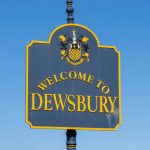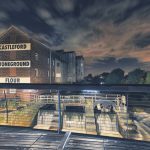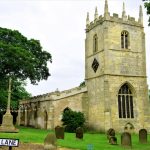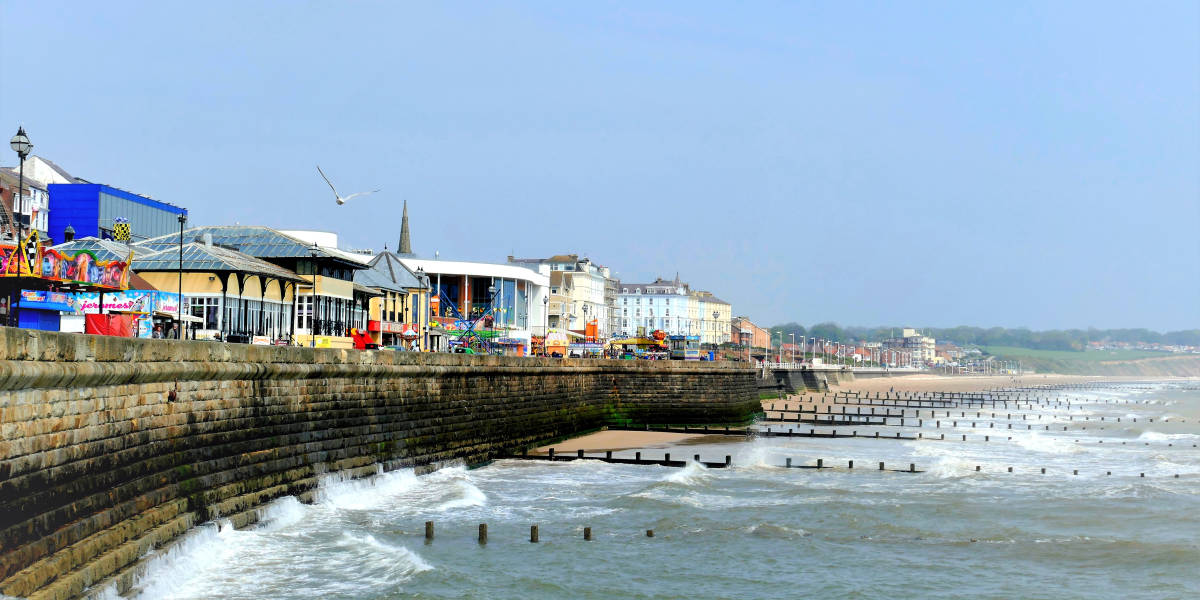
East Riding’s favourite beach beauty spots all revolve around the striking town of Bridlington.
Bridlington is a city by the sea. Population hovering around 34,000, this former Roman camp shows evidence of being a port for far longer than history records. Stone from the quarries here has helped build the surrounding towns and cities. Once part of an intricate system of watches which warned early Angles against invaders. Bridlington has a long history of protecting the coast and trading. We wanted to find out what else Bridlington does for the community.
Here is what the locals whisper in dark corners of the tavern.
What’s Bridlington Famous For?
Bridlington is most famous as a shellfish port. If you have an allergy, this might not be the place for you. It is the largest lobster port in all of Europe, combined with beautiful sandy beaches and RSPB reservations to protect the birdies.
The Early Days of Bridlington
During the Bronze age, most of east Yorkshire was a salt marsh. Although brilliant for certain animal species, it wasn’t great land for settlers and early humans. Nevertheless, there is evidence of barrow burials and bowl barrows registered with Historic England. You can see a full map of what East Riding looked like during that period.
After the Ages came the tribes. Yorkshire was made up of the Parisi tribe and the Brigantes tribe. The Brigantes were a collective of smaller tribes who ruled from the northern borders tight down into Yorkshire. There are traces of prehistoric settlements in this area.
After the tribes came the Romans. They stomped, burned, and conquered everything from the southeast of England right up to the Borders of Scotland. They built stables and waystations, arriving circa 40AD. They made loads of roads and set up garrisons all over the country. One of these camps was in the Bridlington area. The historians think that the Romans chose this place for its harbour, which was already here back in 40AD-ish. Ptolemy mentions a safe-haven bay here.
There are at least four villas within a few miles of each other. All are positioned along the Gypsey Race, which is not a slur but the name of a stream. We cannot testament to the origins of the name though – just please don’t shout at us. The wetter the weather is the more parts of this stream appear. It is at its worst in winter when it is known to break the banks.
It is thought that Bridlington’s name formed sometime after the Romans but before the Vikings. The name is Anglo Saxon, who were the people here before the Romans but after the tribes. In fact, one of those Angle leaders built a network of signals to warn of invading Angles all the way back around 4AD. The name is thought to be Danish/English/Viking, coming from Beohrtel’s Ton – a farm belonging to a man named Beohrtel. Although there have been a few different names over the years, all were similar evolutions of the same thing. Eventually, it became Bridlington and a new age was born.
The Medieval Era
In the Domesday Survey of 1086, the town was mostly fields. There were two owners: the king and the Count Robert of Mortain. Robert’s lands are recorded as maybe wastelands in 1066 and as definitely wastelands in 1086.
The king had one lot of 2 ploughlands which made 1 pound per year in 1066, it was written off as waste in 1086.
The actual Bridlington area was owned by the king and contained 37 fields, 1.5 teams to plough those fields, 8 acres of meadow, 1 Church, 3 villagers, 1 freeman, and 4 burgesses. It was worth 8 shillings, which means there was a whole lot of open space out there. No wonder we caught salt plains.
Let’s not also forget that the king confiscated an existing Manor at Bridlington in 1072 as he crept his invading way north.
Bridlington Priory opened in 1113 at the behest of Augustine monks. Founded by Walter de Gant, a good friend of King Henry I, these priories saw favour from the nobles for a couple of hundred years since they were under the behest of the king and his bishops. These priories were usually richer than others because of that, which is why you have this gorgeous cathedral-esque priory with stunning angles and beauty. Scholars and musicians studied here down the years. Although famous throughout the land, it still suffered the same fate as all the others in the 1537 dissolution of the monasteries.
King John – the same one from the Robin Hood mythos – granted the town the right to hold a market and to house friars. In 1295 Edward I called the Prior to parliament. Worse though, in 1300, the king commanded the prior to going to Carlisle in a conscripted fight against the Scots. In 1319, Edward II spent the night in the prior’s home. In 1388, the town erected the Bayle Gate as a chartered right granted by Richard II – so this area of the country has a long association with the crown.
In 1401 John of Bridlington became a saint and 14 years later Henry V fought in Agincourt and visited the saint’s shrine on his way home. His son funded the formation of the choir and the school in 1450. Later came the dissolution of the monastery and the execution of the last prior.
In 1630 the town gained another charter, this time from Charles I. That same year the manor changed hands to freeholders. The town got a Great Town Deed drawn up. The Dutch invaded in 1666 and robbed the town. The town got a grammar school in 1637, a local baker’s went on fire in 1660, and the city got a knitting school in 1671. The charter for the harbour followed in 1697.
Fun Facts and Trivia from Throughout Bridlington
Let’s take a deep breath and clear our lungs of all those history cobwebs. We dug up a few fun facts from Bridlington through the years to tantalize your brain buds and maybe give you a cool story to tell. Here are the fun things we loved about Bridlington:
- The Baptist church that opened in 1697 in Bridlington was only the second ever built in the whole of Yorkshire.
- The nearby Danes Dyke beach has helped archaeologists prove the plates were once joined. The shore has produced the bones and teeth of a now-extinct type of African elephant. There are few ways these bones could be here other than by ship or by separation of the land.
- In 1890, local lifeboatman Harry Hutchinson won the town’s silver medal for rescuing eight people from a compromised craft.
- Many houses in the town were washed away in the great storm of 1894. The town has been increasing flood defences ever since.
- King Charles (the artist formerly known as Prince) visited the local hospital in 1999 to open a new cancer ward.
- The Bridlington Gazette launched in 1995, the third such local paper.
- In 1993 the local Bridlington Town Football Team played at Wembley to win the FA Vase.
That’s more than enough gossip for one destination, let’s get back to the annals of history.
The Industrial Period
In 1714, the start of the 18th century, the Avenue went up. In 1743 the town gained a workhouse, which was where the poor people went to work themselves to death. In 1767 the town gained a fire engine. A sea battle was fought off the coast in 1779, with William IV landing here in 1787. The sea battle was fought at Flamborough Head. Four years later, shipbuilding became one of the main industries in town, accelerating the worth of the harbour there. The bank and the town’s first hotel were next to open, and then in 1806, the town got its first lifeboat service, presumable to rescue survivors of future sea battles.
In 1811, the 3741 residents shared 869 houses. In 1818 a national school opened and in the following years the town got exceptionally busy. In 1823 they got a windmill and the first policeman got his job. In 1833 the town got a gas service. Charlotte Bronte visited here in 1839 and in her diary, she describes how it is the first time she has ever seen the sea. The last ship built in the yards here was the Queen Dowager, in 1841.
The railway arrived in 1846 and in 1848 the pier opened. The school for infants on Church Green opened in 1857 and the newspaper arrived in 1859. Piped water arrived after 1865 and the first sea wall went up in 1867. Lloyd hospital opened two years later and the year after the Victoria sea wall was added.
In 1871 there was a great gale off the coast. Members of the lifeboat service went out into the storm and never returned. This was the earliest recorded mass loss of life. 6 men drowned. The priory church gained gas in 1872, in 73 the town gained Wesleyan Chapel, the following year the Baptist Church opened, and in 1877 the Promenade Congregational Church opened. In 1881 the Court House and police station both opened. In 1882 there was another methodist church, and a year later gas lit the streets.
Throughout the rest of the industrial period, the town gained a memorial fountain, a cemetery, another two churches, a parade, electricity and lighting, a new slipway road, another church, A public park, a people’s palace, donkey rides on the beach, a new spa, a new gardens, a new post office, a new newspaper, the first telephone at the local hotel – the number being “1” – a penny bank, a fire brigade, a literary and debating society, a new set of bells, golf links, a new pier, a floral pavilion, a sanatorium, a power station, and a visit from the Mayor of London. Suitably progressive for an industrial town of shipbuilding, market days, quarrying and coal mining.
Modern Day Bridlington
By 1911 the town of Bridlington had 14,334 people living in it. The John Bull rock factory opened, and a mine exploded in 1918 and damaged the town. The town gained a pageant, an information bureau, a cenotaph, a paddle steamer, the Kingsgate, recreation grounds, and a winter garden. A promenade, a lounge cinema, a new North Sea wall to keep out the weather, a new town hall, a fish wharf, and a market, sold the Sewersby Estate, gained a pleasure cruiser, and got hit by a bomb in 1940. Fortunately, the only thing damaged was the local Woolworths store.
We are getting tight on space, but needless to say that there were hundreds of advancements in the modern town of Bridlington. In the last fifty years or so, everything that survived from the previous century was turned into an attraction, made into a museum, or knocked down to be rebuilt with bigger and better budgets.
The only Grade I building left is that priory, and it is well worth a viewing. Bridlington is a tourist town as much as it is a small city near Hull. It sits on some stunning coastline, has amazing vibes, and could make a commuter town if you don’t mind a long drive. We give modern Bridlington a double thumbs up. Take a trip to East Riding and see for yourself.
Famous People from Bridlington
By now, you are probably wondering if you are going to rub shoulders with any royalty in Bridlington. Ok, OK, so a celebrity would do. We scooped the names of the biggest celebs from Bridlington out of the sandbox for your perusal:
- William Kent, born in 1685, was an artist and architect born in Bridlington.
- 1752 saw the famous whaler Samuel Standidge was born here.
- A woman called Mary Baynton was from here. She claimed to be the first daughter of Henry VIII. Born around 1515, her story seemed legit until investigators prodded a little deeper. Just as the nobles were about to spirit her off to Spain to garner support to the cause, the authorities took her into custody. It seems that she was released and lived a quiet life. Doesn’t that seem like a strange story for a lie? Claim it, get tortured for a bit, and decide to keep your mouth shut is what it sounds like… Still, it’s a great story.
- A few cricketers have come from here, including Geoff Robinson, Claude Burton, and Cecil Burton.
- Charlie Heaton, who plays Johnnie in Stranger Things, is from Bridlington.
- Rosie Jones, a comedienne from Would I Lie To You? Is from here.
- Helene Palmer from Coronation Street.
- In 1822, the guy who organised Crimean War Hospitals was born here. His name was Humphrey Sandwidth.
There are another fifty or more but we are running out of space. Needless to say that there have been a fair few famous faces on Bridlington streets over the years.
What Has Bridlington Got To Offer
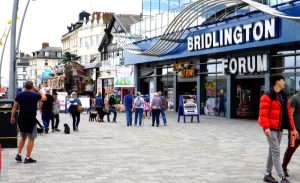
Image: Oscar Johns/Shutterstock.om
During this section of any given tour/travel guide, we like to add in the best attractions from in and around town. These are voted for by locals and include the best things to see and do in Bridlington.
Historic Sites
There is a Grade I listed building on the grounds of the old priory in Bridlington. Bridlington Priory, with its very imaginative name, has stained glass windows, a gothic style with lots of pointy turrets, huge indoor arches, and symbols of the type which might inspire a Dan Brown novel. Pay it a visit to reflect in quiet contemplation or go along for a service.
Landmarks
Head to the jaw-dropping RSPB Bempton Cliffs. These cliffs are home to a wide range of sea birds including one of our favourites the Puffin. If you are a bird watcher or keen photographer you are in for a treat. Even if Ornithology is not your thing they are still well worth seeing.
You can’t walk the shore here without spotting the Flamborough Lighthouse at night. Have a walk around and keep the curtains closed if you are trying to sleep.
Cultural Attractions in Bridlington
Go to the early 20th-century John Bull Rock Factory and enjoy the sweet treats the town is so well-known for. They still operate to this day and also offer tours. Think Charlie and the Chocolate Factory but without the singing purple dudes.
You should go learn about the local history at the Bayle Museum.
Check out the Bondville Model Village, too. The details are amazing in this niche museum. You will find it nestled next to the amazing Sewersby Cliffs. Make an afternoon of it and see them both.
Outdoor Attractions
Bridlington has so many good beaches within a short drive or long walk’s distance. Bridlington North Beach is approximately 1.2 miles from the town centre. You also have Wilsthorpe beach the same distance away. Then at 1.8 miles, there is Fraisthorpe Beath, with Earl’s Dye 2.3 miles away. You also have Barmston, Dandes Dyke, Skipsea, and a few others.
Head out to Bridlington Animal Park if you have any kiddies with you. This place is buzzing with life. Pet some animals, learn about the birds and generally enjoy this zoo.
Teams and Sports
The local football club is Bridlington Town AFC, also known as the Seasiders. They have been kicking about the town for a long time now. They play in the Northern Premier League Division.
Asides from the local football club, several cricketers make it big through the cricket club here. Bridlington CC is one of the best-known in the country, especially throughout Yorkshire. There are multiple winning cricketers to come from this club. Take it seriously or not at all.
Bridlington also has its own rugby club, find out more about Bridlington RUFC here.
Let’s not move on without visiting Bridlington Golf Club, the Yorkshire Coast Golf Club, or the Bridlington Links Golf Course to choose from.
Where to shop in Bridlington?
There are two great places to shop near Bridlington. One is in the Promenade Shopping Centre in the centre of town. The next best shopping mall is in Flemingate, on the road to Hull. You will find more shopping in the town centre, too.
Where to eat and drink?
There are three main restaurants you should visit here, although there are many more which are just as good. Check out Aloha, with outdoor dining, steaks, and sea views. If you prefer less fine food and more pie, check out the Freeman Cookhouse and Pub. If you don’t want a pint with your plate, head to the Lamp Restaurant.
Other Notable Attractions
There are several great nearby locations where you can expand your adventures if you were to visit Bridlington. These surrounding attractions offer extra things to see and do here, should you take our advice and come here for a long weekend or holiday. Here are some notable nearby attractions:
- Visit the ancient cathedral in Ripon a few miles west.
- Go to Batley to visit the original Fox’s Biscuits factory.
- Barnsley in the South is inside the beautiful Dearne Valley.
- The nearest big city is Hull.
- And the other nearest big city is York.
How to get to Bridlington?
We will attempt to give you directions to get to Bridlington but we are notorious for sending people into the centre of the sun by accident. Here are our loose directions but you will have to figure out the rest on your own.
By Road
Follow the A166 out of York and through Stamford Bridge, and keep going till you hit Bridlington.
By Rail
Bridlington train station is on the northern line.
By Air
Humberside airport is nearest, with Leeds Bradford 60 miles away or so.
By Sea
Bridlington has its own harbour. There is a Port at Mulgrave and Scarborough harbour and marina too.
Got Five Minutes
Before you rush off to go about your day as normal, we have a favour to ask. Catch up with us on Facebook and drop us a like or a follow. We appreciate every one of our lovely readers who has helped us out with this in the past – but we want more! What better way is there to keep up to date with the Brits?
Header Image: Oscar Johns/Shutterstock.com


